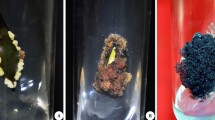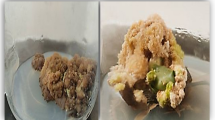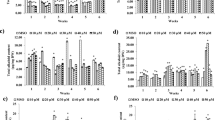Abstract
Clausena harmandiana (Pierre) Guillaumin is the Thai medicinal plant that possessed several pharmacological activities. The main active constituents of this plant are the carbazole alkaloids, isolated from wild plants. However, the in vitro culture for production of carbazole alkaloids from this plant has never been reported. Therefore, we aimed to develop callus culture of C. harmandiana elicited with two biotic elicitors, Trichoderma harzianum and Bacillus subtilis, as a sustainable source of carbazole alkaloids. The callus treated with living B. subtilis (BL) at 0.1 and 1% (v/v) for 3 days accumulated 5-fold increased level of clausine K. The highest level reached 309.37 ± 34.84 μg/g DW. This treatment also showed a significant increase in both total phenolic content and antioxidant capacity, which support the optimum usage of this elicitor. Moreover, only callus treated with 1% (v/v) Trichoderma culture filtrate (CF) showed a significant increase in the total phenolic contents and antioxidant capacity. The correlation analysis also revealed the significant correlation between antioxidant capacity and total phenolic level, total flavonoids, and clausine K but not 7-methoxymukonal. The results from our study suggested the use of C. harmandiana callus with the Bacillus elicitors for high-level production of clausine K.





Similar content being viewed by others
References
Huang, L., Feng, Z.-L., Wang, Y.-T., & Lin, L.-G. (2017). Anticancer carbazole alkaloids and coumarins from Clausena plants: a review. Chinese Journal of Natural Medicines, 15(12), 881–888.
Greger, H. (2017). Phytocarbazoles: alkaloids with great structural diversity and pronounced biological activities. Phytochemistry Reviews, 16(6), 1095–1153.
Yenjai, C., Sripontan, S., Sriprajun, P., Kittakoop, P., Jintasirikul, A., Tanticharoen, M., & Thebtaranonth, Y. (2000). Coumarins and carbazoles with antiplasmodial activity from Clausena harmandiana. Planta Medica, 66(03), 277–279.
Chaichantipyuth, C., Pummangura, S., Naowsaran, K., Thanyavuthi, D., Anderson, J. E., & McLaughlin, J. L. (1988). Two new bioactive carbazole alkaloids from the root bark of Clausena harmandiana. Journal of Natural Products, 51(6), 1285–1288.
Thongthoom, T., Songsiang, U., Phaosiri, C., & Yenjai, C. (2010). Biological activity of chemical constituents from Clausena harmandiana. Archives of Pharmacal Research, 33(5), 675–680.
Songsiang, U., Thongthoom, T., Boonyarat, C., & Yenjai, C. (2011). Claurailas a−d, cytotoxic carbazole alkaloids from the roots of Clausena harmandiana. Journal of Natural Products, 74(2), 208–212.
Maneerat, W., Phakhodee, W., Ritthiwigrom, T., Cheenpracha, S., Promgool, T., Yossathera, K., Deachathai, S., & Laphookhieo, S. (2012). Antibacterial carbazole alkaloids from Clausena harmandiana twigs. Fitoterapia, 83(6), 1110–1114.
Sriphana, U., Thongsri, Y., Prariyachatigul, C., Pakawatchai, C., & Yenjai, C. (2013). Clauraila E from the roots of Clausena harmandiana and antifungal activity against Pythium insidiosum. Archives of Pharmacal Research, 36(9), 1078–1083.
Songsiang, U., Thongthoom, T., Zeekpudsa, P., Kukongviriyapan, V., Boonyarat, C., Wangboonskul, J., & Yenjai, C. (2012). Antioxidant activity and cytotoxicity against cholangiocarcinoma of carbazoles and coumarins from Clausena harmandiana. Science-Asia, 38(1), 75–81.
Sunthitikawinsakul, A., Kongkathip, N., Kongkathip, B., Phonnakhu, S., Daly, J. W., Spande, T. F., Nimit, Y., & Rochanaruangrai, S. (2003). Coumarins and carbazoles from Clausena excavata exhibited antimycobacterial and antifungal activities. Planta Medica, 69(2), 155–157.
Xia, H.-M., Ou Yang, G.-Q., Li, C.-J., Yang, J.-Z., Ma, J., Zhang, D., Li, Y., Li, L., & Zhang, D.-M. (2015). Clauemarazoles A–G, seven carbazole alkaloids from the stems of Clausena emarginata. Fitoterapia, 103, 83–89.
Kongkathip, B., Kongkathip, N., Sunthitikawinsakul, A., Napaswat, C., & Yoosook, C. (2005). Anti-HIV-1 constituents from Clausena excavata: part II. Carbazoles and a pyranocoumarin. Phytotherapy Research, 19(8), 728–731.
Bourgaud, F., Gravot, A., Milesi, S., & Gontier, E. (2001). Production of plant secondary metabolites: a historical perspective. Plant Science, 161(5), 839–851.
Ramachandra Rao, S., & Ravishankar, G. A. (2002). Plant cell cultures: chemical factories of secondary metabolites. Biotechnology Advances, 20(2), 101–153.
Zhao, J., Davis, L. C., & Verpoorte, R. (2005). Elicitor signal transduction leading to production of plant secondary metabolites. Biotechnology Advances, 23(4), 283–333.
Verpoorte, R., Contin, A., & Memelink, J. (2002). Biotechnology for the production of plant secondary metabolites. Phytochemistry Reviews, 1(1), 13–25.
Shoresh, M., Harman, G. E., & Mastouri, F. (2010). Induced systemic resistance and plant responses to fungal biocontrol agents. Annual Review of Phytopathology, 48(1), 21–43.
Fira, D., Dimkić, I., Berić, T., Lozo, J., & Stanković, S. (2018). Biological control of plant pathogens by Bacillus species. Journal of Biotechnology, 285, 44–55.
Ramezani, A., Haddad, R., Sedaghati, B., & Jafari, D. (2018). Effects of fungal extracts on vinblastine and vincristine production and their biosynthesis pathway genes in Catharanthus roseus. South African Journal of Botany, 119, 163–171.
Verma, P., Khan, S. A., Mathur, A. K., Shanker, K., & Kalra, A. (2014). Fungal endophytes enhanced the growth and production kinetics of Vinca minor hairy roots and cell suspensions grown in bioreactor. Plant Cell, Tissue and Organ Culture (PCTOC), 118(2), 257–268.
Namdeo, A., Patil, S., & Fulzele, D. P. (2008). Influence of fungal elicitors on production of ajmalicine by cell cultures of Catharanthus roseus. Biotechnology Progress, 18, 159–162.
Verma, P., Khan, S. A., Mathur, A. K., Ghosh, S., Shanker, K., & Kalra, A. (2014). Improved sanguinarine production via biotic and abiotic elicitations and precursor feeding in cell suspensions of latex-less variety of Papaver somniferum with their gene expression studies and upscaling in bioreactor. Protoplasma, 251(6), 1359–1371.
Orlita, A., Sidwa-Gorycka, M., Malinski, E., Czerwicka, M., Kumirska, J., Golebiowski, M., Lojkowska, E., & Stepnowski, P. (2008). Effective biotic elicitation of Ruta graveolens L. shoot cultures by lysates from Pectobacterium atrosepticum and Bacillus sp. Biotechnology Letters, 30(3), 541–545.
Smetanska, I. (2008). In U. Stahl, U. E. B. Donalies, & E. Nevoigt (Eds.), Food biotechnology (pp. 187–228). Berlin: Springer Berlin Heidelberg.
Daodee, S., Wangboonskul, J., Yenjai, C., Boonyarat, C., & Monthakantirat, O. (2012). Determination of five carbazole alkaloids from the root of Clausena harmandiana by high performance liquid chromatography. Isan Journal of Pharmaceutical Sciences, 8, 94–100.
Murashige, T., & Skoog, F. (1962). A revised medium for rapid growth and bio assays with tobacco tissue cultures. Physiologia Plantarum, 15(3), 473–497.
Ainsworth, E. A., & Gillespie, K. M. (2007). Estimation of total phenolic content and other oxidation substrates in plant tissues using Folin–Ciocalteu reagent. Nature Protocols, 2(4), 875–877.
Chang, C.-C., Yang, M.-H., Wen, H.-M. and Chern, J.-C. (2002) Estimation of total flavonoid content in propolis by two complementary colorimetric methods. Journal of Food and Drug Analysis, 10(3), 178–182.
Wojdyło, A., Oszmiański, J., & Czemerys, R. (2007). Antioxidant activity and phenolic compounds in 32 selected herbs. Food Chemistry, 105(3), 940–949.
Brand-Williams, W., Cuvelier, M. E., & Berset, C. (1995). Use of a free radical method to evaluate antioxidant activity. LWT - Food Science and Technology, 28(1), 25–30.
Benzie, I. F. F., & Strain, J. J. (1996). The ferric reducing ability of plasma (FRAP) as a measure of “antioxidant power”: the FRAP assay. Analytical Biochemistry, 239(1), 70–76.
Harborne, J. B. (1984). In J. B. Harborne (Ed.), Phytochemical methods: a guide to modern techniques of plant analysis (pp. 37–99). Dordrecht: Springer Netherlands.
Chang, X., Ye, Y., Pan, J., Lin, Z., Qiu, J., Guo, X., & Lu, Y. (2018). Comparative assessment of phytochemical profiles and antioxidant activities in selected five varieties of wampee (Clausena lansium) fruits. International Journal of Food Science & Technology, 53(12), 2680–2686.
Deng, H.-D., Cai, C.-H., Liu, S., Zeng, Y.-B., Mei, W.-L., He, F., Hua, M., Dai, H.-F., & Li, S.-P. (2016). A new monoterpenoid and a new flavonoid glycoside from the peels of Clausena lansium. Natural Product Communications, 11(5), 573–575.
Seo, C., Ahn, E.-K., Kang, J.-S., Lee, J.-H., Oh, J. S., & Hong, S. S. (2017). Excavasides A and B, two new flavonoid glycosides from Clausena excavata Burm. f. (Rutaceae). Phytochemistry Letters, 20, 93–97.
Rice-Evans, C., Miller, N., & Paganga, G. (1997). Antioxidant properties of phenolic compounds. Trends in Plant Science, 2(4), 152–159.
Funding
This work was supported by the funding from The Thailand Research Fund (IRN61W0005) and the financial support from the scholarship under the Postdoctoral Training Program from the Research Affairs and Graduate School, Khon Kaen University, Thailand (Grant No. 58439-2).
Author information
Authors and Affiliations
Corresponding author
Ethics declarations
Conflict of Interest
The authors declare that they have no conflict of interest.
Additional information
Publisher’s Note
Springer Nature remains neutral with regard to jurisdictional claims in published maps and institutional affiliations.
Rights and permissions
About this article
Cite this article
Boonsnongcheep, P., Daodee, S., Kitisripanya, T. et al. Increased Carbazole Alkaloid Accumulation in Clausena harmandiana Callus Culture by Treatments of Biocontrol Agent, Trichoderma harzianum and Bacillus subtilis. Appl Biochem Biotechnol 189, 871–883 (2019). https://doi.org/10.1007/s12010-019-03037-7
Received:
Accepted:
Published:
Issue Date:
DOI: https://doi.org/10.1007/s12010-019-03037-7




